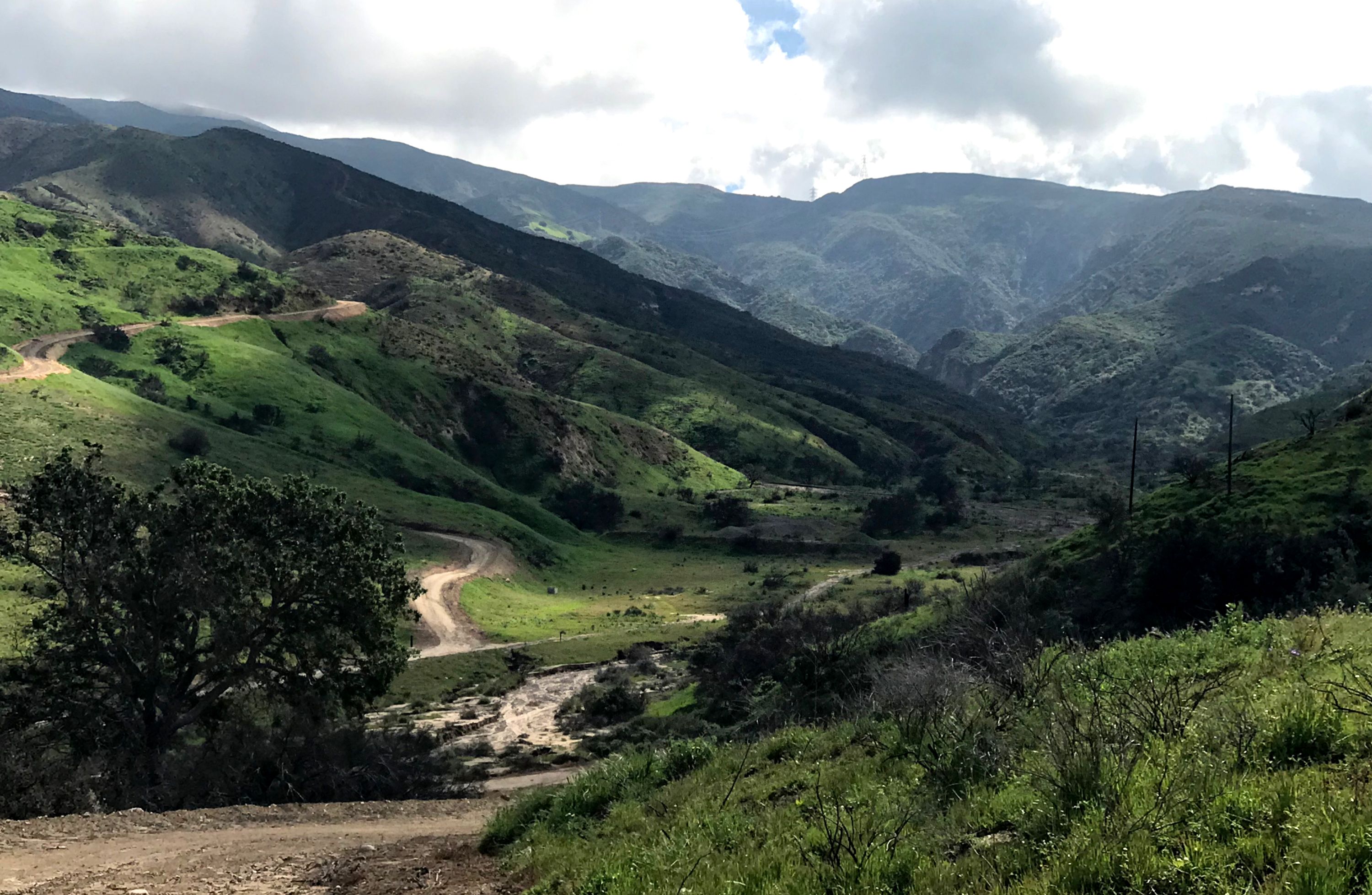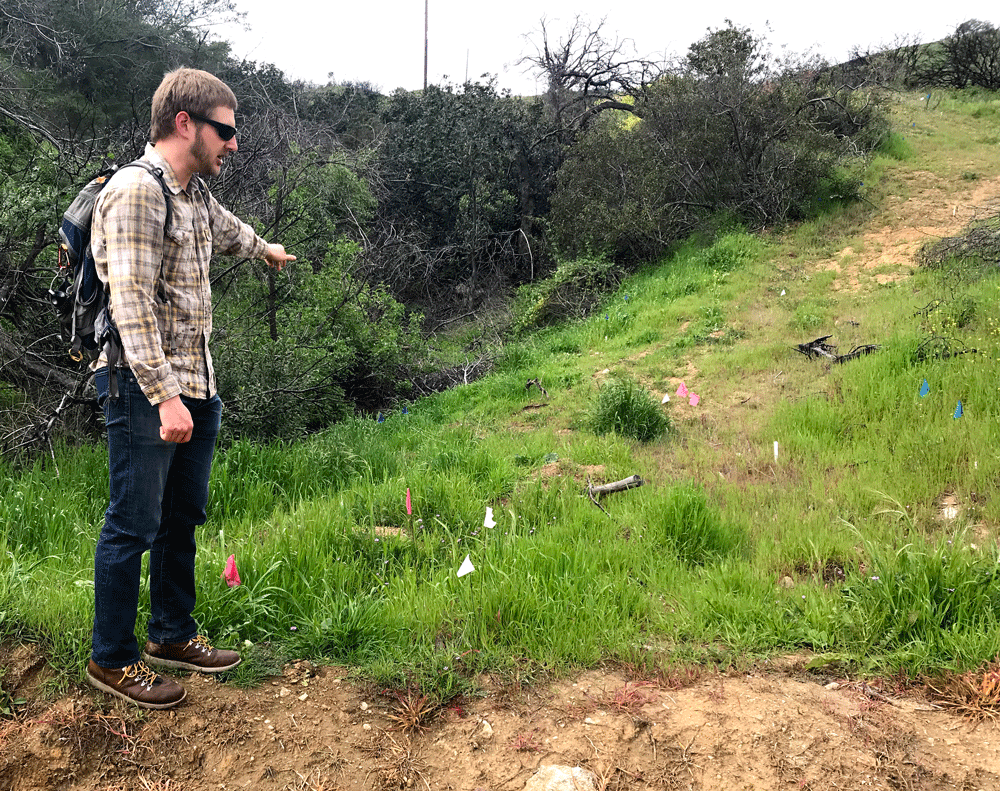The Impact of Firebreaks in Southern California Sage Lands

A canyon in Chino Hills State Park.
In author George R.R. Martin’s Song of Ice and Fire books, the noble families of Westeros vie for power and the Iron Throne to see who will rule over the land.
In Noah Teller’s study of bulldozer lines and firebreaks, native and invasive plants vie for resources to see who will rule over the landscape.
“It’s Game of Thrones in the plant community,” he said, standing beside a firebreak cut during 2017 wildfires in Chino Hills State Park outside Riverside, California. “We think there’s a lot of really interesting intrigue and backstabbing and war going on in the plant communities behind us, but there’s a lot of facilitation and cooperation, too.”
Doctoral student Teller, UC Riverside professors Loralee Larios and Travis Bean, and Elise Gornish from the University of Arizona received a Western Integrated Pest Management Center grant in 2018 to fund the research. They are looking specifically at the firebreaks to see if they’re having a negative ecological impact and, if so, how that can be mitigated.
“During those fires, the firefighting authorities used bulldozers as well as hand crews to cut firebreaks to remove vegetation and prevent the fire from spreading,” he said. “And while these techniques are critically important for effective firefighting, they can also have lasting impacts on the recovery of vegetation after they are applied. We're interested in seeing what's different about what's coming in within the bulldozer lines versus what's next to them.”

Noah Teller at a firebreak in the study.
Teller’s looking to answer a few specific questions. One is how bulldozers distribute seeds – especially the seeds of invasive annual grasses – across the landscape. Working from established roadways and fire roads, dozer drivers typically set their blades down at the road edge and push up the hillside to clear vegetation to stop flames. But those road edges are often thick with invasive grasses.
“Unfortunately, there is a large propensity for bulldozers to pick up seeds of invasive plants and move them uphill,” Teller said. “We're particularly concerned that in previously uninvaded areas farther uphill, the bulldozer may have pushed invasive plant seeds where they weren't before, which risks type-converting native vegetation.”
Type-conversion – the replacement of the area’s natural, diverse vegetation with annual grasses – is the big concern.
“Annual grasses produce a lot of foliage every year that then dries down in the summer to be very papery, flammable vegetation, and they also are really effective at filling in spaces between plants to create more fuel connectivity on the landscape,” Teller explained. “Before these grasses got here, fire would burn through and leave patches that acted as natural firebreaks to allow native plants to survive. Now we've got this cover of invasive grass that carries fire through the community really efficiently and that means more plants are burning more frequently than they ever have before.”
To measure seed dispersal by bulldozer activity, Teller placed seed traps perpendicular to the bulldozer lines at near, middle and far distances from the road to see the composition and abundance of seeds that later fall back to the soil. Control traps were placed in the same configuration in nearby undisturbed areas as well.
Replanting Right
The second big question the team hopes to answer is what kind of seed mix is best to replant disturbed areas.
“These seed mixes are designed to accomplish two specific management goals,” Teller explained. “One is the suppression of invasive species and the other is the maintenance of native species in these bulldozer lines.”
To determine which native species would best accomplish those goals, researchers measured key competitive traits on native and invasive species in a greenhouse study in 2018 and created two seed mixes to test.
One is a mix of native plants that are trait-matched to mimic invasive annual grasses. They are species with thin, flexible leaves that grow and add biomass quickly and fibrous roots that rapidly draw down water from the top of the soil. The other mix is designed to have maximum trait diversity with a variety of leave types, root configurations and plant heights.
“Our thought was that the first mix would potentially suppress invasive plants by competing in same ecological niche, and the second, with as many different traits as possible, might be more robust to dealing with environmental fluctuations like drought or excessive rain years,” Teller said. “A larger diversity of trait mixes could respond positively to conditions in any given year.”
The two seed mixes were planted in the fall of 2018 using seed collected from the immediate area in Chino Hills and the initial evaluations will take place in April of this year, with more years to follow.
“Since we’re going to be engaging in destructive but necessary firefighting techniques on these landscapes, our goal is to understand some of the ways we can mitigate the unintended consequences of those techniques,” Teller said. “How can we maintain these communities with a native species assemblage that is beautiful, that lasts for many generations and that doesn't catch fire so frequently and produce other problems?”